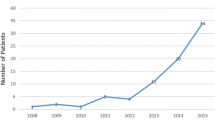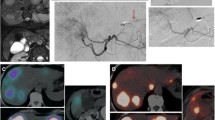Abstract
Purpose
While influx of chemoembolic agents into the hepatic falciform artery (HFA) from the hepatic artery can cause supraumbilical skin rash, epigastric pain and even skin necrosis, the significance of a patent HFA in patients undergoing radioembolization is not completely clear. Furthermore, the presence of tracer in the anterior abdominal wall seen in 99mTc-macroaggregated albumin (99mTc-MAA) images, which is generally performed prior to radioembolization, has been described as a sign of a patent HFA. The aim of this retrospective study was to evaluate the incidence and consequences of 99mTc-MAA accumulation in the anterior abdominal wall, indicating a patent HFA, in patients undergoing radioembolization of liver tumours.
Methods
A total of 224 diagnostic hepatic angiograms combined with 99mTc-MAA SPECT/CT were acquired in 192 patients with different types of cancer, of whom 142 were treated with a total of 214 radioembolization procedures. All patients received a whole-body scan, and planar and SPECT/CT scans of the abdomen. Only patients with extrahepatic 99mTc-MAA accumulation in the anterior abdominal wall were included in this study. Posttreatment bremsstrahlung SPECT/CT and follow-up results for at least 3 months served as reference standards.
Results
Tracer accumulation in the anterior abdominal wall was present in pretreatment 99mTc-MAA SPECT/CT images of 18 patients (9.3%). The HFA was found and embolized by radiologists before treatment in one patient. In the remaining patients radioembolization was performed without any modification in the treatment plan despite the previously mentioned extrahepatic accumulation. Only one patient experienced abdominal muscle pain above the navel, which started 24 h after treatment and lasted for 48 h without any skin changes. The remaining patients did not experience any relevant side effects during the follow-up period.
Conclusion
Side effects after radioembolization in patients with tracer accumulation in the anterior abdominal wall on 99mTc-MAA scans indicating a patent HFA are neither common nor severe. Thus, there is no absolute need for prophylactic embolization of the HFA or modification of the treatment plan if the HFA is not detectable on angiography.





Similar content being viewed by others
References
Ahmadzadehfar H, Biersack HJ, Ezziddin S. Radioembolization of liver tumours with yttrium-90 microspheres. Semin Nucl Med. 2010;40:105–21. doi:10.1053/j.semnuclmed.2009.11.001.
Murthy R, Nunez R, Szklaruk J, Erwin W, Madoff DC, Gupta S, et al. Yttrium-90 microsphere therapy for hepatic malignancy: devices, indications, technical considerations, and potential complications. Radiographics. 2005;25 Suppl 1:S41–55. doi:10.1148/rg.25si055515.
Salem R, Thurston KG. Radioembolization with 90Yttrium microspheres: a state-of-the-art brachytherapy treatment for primary and secondary liver malignancies. Part 1: Technical and methodologic considerations. J Vasc Interv Radiol. 2006;17:1251–78. doi:10.1097/01.RVI.0000233785.75257.9A.
Kennedy A, Nag S, Salem R, Murthy R, McEwan AJ, Nutting C, et al. Recommendations for radioembolization of hepatic malignancies using yttrium-90 microsphere brachytherapy: a consensus panel report from the radioembolization brachytherapy oncology consortium. Int J Radiat Oncol Biol Phys. 2007;68:13–23. doi:10.1016/j.ijrobp.2006.11.060.
Leung TW, Lau WY, Ho SK, Ward SC, Chow JH, Chan MS, et al. Radiation pneumonitis after selective internal radiation treatment with intraarterial 90yttrium-microspheres for inoperable hepatic tumors. Int J Radiat Oncol Biol Phys. 1995;33:919–24..
Murthy R, Brown DB, Salem R, Meranze SG, Coldwell DM, Krishnan S, et al. Gastrointestinal complications associated with hepatic arterial yttrium-90 microsphere therapy. J Vasc Interv Radiol. 2007;18:553–62. doi:10.1016/j.jvir.2007.02.002.
Carretero C, Munoz-Navas M, Betes M, Angos R, Subtil JC, Fernandez-Urien I, et al. Gastroduodenal injury after radioembolization of hepatic tumors. Am J Gastroenterol. 2007;102:1216–20. doi:10.1111/j.1572-0241.2007.01172.x.
Salem R, Parikh P, Atassi B, Lewandowski RJ, Ryu RK, Sato KT, et al. Incidence of radiation pneumonitis after hepatic intra-arterial radiotherapy with yttrium-90 microspheres assuming uniform lung distribution. Am J Clin Oncol. 2008;31:431–8. doi:10.1097/COC.0b013e318168ef65.
Yip D, Allen R, Ashton C, Jain S. Radiation-induced ulceration of the stomach secondary to hepatic embolization with radioactive yttrium microspheres in the treatment of metastatic colon cancer. J Gastroenterol Hepatol. 2004;19:347–9.
Atassi B, Bangash AK, Lewandowski RJ, Ibrahim S, Kulik L, Mulcahy MF, et al. Biliary sequelae following radioembolization with Yttrium-90 microspheres. J Vasc Interv Radiol. 2008;19:691–7. doi:10.1016/j.jvir.2008.01.003.
Riaz A, Lewandowski RJ, Kulik LM, Mulcahy MF, Sato KT, Ryu RK, et al. Complications following radioembolization with yttrium-90 microspheres: a comprehensive literature review. J Vasc Interv Radiol. 2009;20:1121–30. doi:10.1016/j.jvir.2009.05.030.
Ahmadzadehfar H, Sabet A, Biermann K, Muckle M, Brockmann H, Kuhl C, et al. The significance of 99mTc-MAA SPECT/CT liver perfusion imaging in treatment planning for 90Y-microsphere selective internal radiation treatment. J Nucl Med. 2010;51:1206–12. doi:10.2967/jnumed.109.074559.
Hamami ME, Poeppel TD, Muller S, Heusner T, Bockisch A, Hilgard P, et al. SPECT/CT with 99mTc-MAA in radioembolization with 90Y microspheres in patients with hepatocellular cancer. J Nucl Med. 2009;50:688–92. doi:10.2967/jnumed.108.058347.
Baba Y, Miyazono N, Ueno K, Kanetsuki I, Nishi H, Inoue H, et al. Hepatic falciform artery. Angiographic findings in 25 patients. Acta Radiol. 2000;41:329–33.
Williams DM, Cho KJ, Ensminger WD, Ziessman HA, Gyves JW. Hepatic falciform artery: anatomy, angiographic appearance, and clinical significance. Radiology. 1985;156:339–40.
Gibo M, Hasuo K, Inoue A, Miura N, Murata S. Hepatic falciform artery: angiographic observations and significance. Abdom Imaging. 2001;26:515–9.
Song SY, Chung JW, Lim HG, Park JH. Nonhepatic arteries originating from the hepatic arteries: angiographic analysis in 250 patients. J Vasc Interv Radiol. 2006;17:461–9. doi:10.1097/01.rvi.0000202718.16416.18.
Leong QM, Lai HK, Lo RG, Teo TK, Goh A, Chow PK. Radiation dermatitis following radioembolization for hepatocellular carcinoma: a case for prophylactic embolization of a patent falciform artery. J Vasc Interv Radiol. 2009;20:833–6. doi:10.1016/j.jvir.2009.03.011.
Chernyak I, Bester L, Freund J, Richardson M. Anterior abdominal wall uptake in intrahepatic arterial brachytherapy with yttrium-90 sir spheres for hepatic malignancy. Clin Nucl Med. 2008;33:677–80. doi:10.1097/RLU.0b013e318184b44f.
Liu DM, Salem R, Bui JT, Courtney A, Barakat O, Sergie Z, et al. Angiographic considerations in patients undergoing liver-directed therapy. J Vasc Interv Radiol. 2005;16:911–35. doi:10.1097/01.RVI.0000164324.79242.B2.
Kao YH, Tan AE, Khoo LS, Lo RH, Chow PK, Goh AS. Hepatic falciform ligament Tc-99 m-macroaggregated albumin activity on SPECT/CT prior to Yttrium-90 microsphere radioembolization: prophylactic measures to prevent non-target microsphere localization via patent hepatic falciform arteries. Ann Nucl Med. 2011. doi:10.1007/s12149-010-0464-9.
Conflicts of interest
None.
Author information
Authors and Affiliations
Corresponding author
Additional information
Hojjat Ahmadzadehfar and Markus Möhlenbruch contributed equally to this work.
Rights and permissions
About this article
Cite this article
Ahmadzadehfar, H., Möhlenbruch, M., Sabet, A. et al. Is prophylactic embolization of the hepatic falciform artery needed before radioembolization in patients with 99mTc-MAA accumulation in the anterior abdominal wall?. Eur J Nucl Med Mol Imaging 38, 1477–1484 (2011). https://doi.org/10.1007/s00259-011-1807-z
Received:
Accepted:
Published:
Issue Date:
DOI: https://doi.org/10.1007/s00259-011-1807-z




